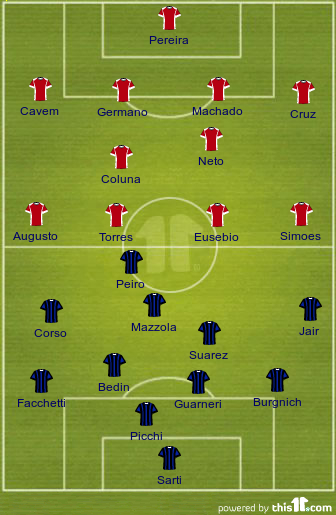Catenaccio
After Karl Rappan and his Verrou the system that came to be known as Catenaccio was the next logical step. If his boasts are to be believed the man that formulated the system was Gipo Viana, the manager of Salernitana in the late 1940s. What the system involved was the moving of one of the wing-halves to drop into the back line, with then the stopper centre-back moving deeper still and acting as the sweeper or libero (free man).
The actual variance of this system from the Verrou was minimal in terms of formation, but was more of a change in terms of attitude. The system that Salernitana used was far more defensive that that of Rappan and its primary purpose was to avoid defeat. Salernitana used it to good effect as they won promotion to Serie A in 1947 with the league’s best defensive record, but the next season they were poor and failed to win a single away game as they were relegated.
Nereo Rocco, the great Milan manager, was the first though to popularise the system, when he worked at hometown club Triestina. Remarkably for a side of such limited means, Triestina managed to finish second in Serie A and were unbeaten at home all season. Given the resources he had to work with Rocco had achieved a miracle, and while he unquestionably possessed excellent motivational skills, no small part of their achievement was attributable to the defensive solidity provided to them by the Catenaccio system.
When Rocco eventually did take charge of Milan, he deployed a form of Catenaccio there and again found significant success. Their style of play though was far less defensive than he had used at Triestina or Viana had at Salernitana. Indeed Milan won the Scudetto in the 1961-2 season as top goal scorers in Serie A with eighty three goals. Rocco was though always suspicious of the less workmanlike players. Jimmy Greaves was quickly packed off back to England despite his prolific record at Milan, and there were times that even the Golden Boy, Gianni Rivera, was out of favour. Milan though stormed to victory in the European Cup in 1963 and established just how powerful the formation could be.
No team are more associated with Catenaccio though than Inter. Under Helenio Herrera, the Nerazzuri defined Catenaccio and were largely responsible for the negative image that it retains to today. Rather than playing with one sweeper behind three defenders and then having a centre-half or centre midfielder act as playmaker, Herrera opted for the added security of using an anchor in midfield to give a further line on protection. Gianfranco Bedin was the man charged with the role and he would sit deep and screen the defence of attackers, leaving Luis Suarez in front of him as the midfield playmaker.
In the defence, Armando Picchi acted as Libero, but he was a far cry from the traditional idea of a cultured sweeper bringing the ball out of defence. Picchi was effectively a stopper who played as the free man, and was very much a safety first defender. In front of Picchi played Aristide Guarneri as the centre-back and to his right was Tarcisio Burgnich, playing somewhere between centre-back and a right-fullback.
On the left of the back line was Giacinto Facchetti, who offered much of the attacking verve of the team. Arguably the first wing-back in the game Facchetti was happy to bomb up and down the left touchline and offered support to the attack. This allowed Mario Corso, the nominal left-winger, to drop inside and assist Suarez in his playmaking role. The team was naturally unbalanced due to Jair’s willingness to drop deep on the right side of midfield which allowed Bugnich to shuffle inside, but it was certainly effective. Inter won Serie A in 1963, 1965 and 1966, and won the European Cup in 1964 and 1965. In addition they were beaten finalists in 1967 to Celtic.
 |
| Inter (below) v. Benfica, 1965 |
Herrera always maintained that his was not a defensive side, and that it was only low quality imitators who gave Catenaccio a bad name. However, the negativity of Inter’s team in a number of their clashes, most notably the European Cup final of 1967, left fee neutrals as great admirers of the system. Bill Shankly hailed Jock Stein as “immortal” for defeating Herrera in that game and proving to the world that more positive play could gain success.

No comments:
Post a Comment